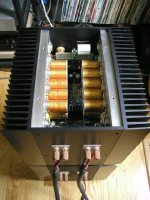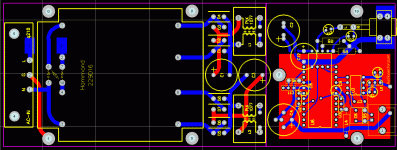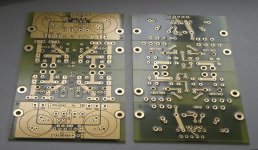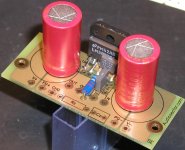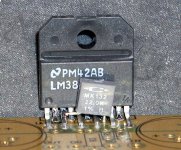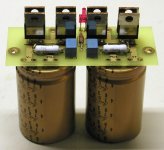I'm here, but I still have to pick up the pieces (of the DAC offer) 😉
I choose BNC, because it's a better type of connector for digital. If someone wants RCA I will include adaptor. I also think that Vampire board mount RCA is interchangable with BNC, so it can be substituted.
The board will be probably $35, There will be at least two different kit versions partswise and one offered completely assembled. I'm not sure about prices yet.
I have two different board layouts, one with transformer, one without. I will be ordering the first one next week, the second one is being fabricated in Europe and will be available within a month.
I choose BNC, because it's a better type of connector for digital. If someone wants RCA I will include adaptor. I also think that Vampire board mount RCA is interchangable with BNC, so it can be substituted.
The board will be probably $35, There will be at least two different kit versions partswise and one offered completely assembled. I'm not sure about prices yet.
I have two different board layouts, one with transformer, one without. I will be ordering the first one next week, the second one is being fabricated in Europe and will be available within a month.
Peter,
You are a very talented mechanical designer. Have you given any thought to perhaps adding chassis/enclosures for non gainclone amplifiers? Based on the response to the group buys jrsun sponsors there may be a market for a sturdy, well designed chassis for a 100 watt class A or 200 watt AB amplifier. I dislike (but really have no choice) the chassis fabrication when DIYing an amp. I have been on Google and there are just very few manufacturers who offer this type of product.
You are a very talented mechanical designer. Have you given any thought to perhaps adding chassis/enclosures for non gainclone amplifiers? Based on the response to the group buys jrsun sponsors there may be a market for a sturdy, well designed chassis for a 100 watt class A or 200 watt AB amplifier. I dislike (but really have no choice) the chassis fabrication when DIYing an amp. I have been on Google and there are just very few manufacturers who offer this type of product.
I checked WIKI page started by jrsun and it seems like are only 5 inquieries with regards to big amp chassis. I don't think such chassis would be very popular.
It is my opinion that the chassis I created for A-75 amp was the simplest approach, and it presented itself quite nicely, but even simple chassis like that is quite expensive to make.
You have to buy at least 100 heatsink extrusions to qualify for $50 price, then fabricating additional panels and brackets might run you another $100. So we already up to $200 per chassis. To make the offer profitable, I would have to be selling it for at least $300, but even then all the trouble with packaging and shipping such big item doesn't make it appealing at all.
One way to do it, would be creating a kit that is used with a given heatsink extrusion and size (while everybody interested would orders heatsinks personally from a same vendor like it was done in a past: R-Theta group buy). But this would require to drill holes in the heatsinks by the end user and complicates the assembly.
Considering all the hard work and trouble involved in organizing and delivering such kit, there is simply no profit in it.
It is my opinion that the chassis I created for A-75 amp was the simplest approach, and it presented itself quite nicely, but even simple chassis like that is quite expensive to make.
You have to buy at least 100 heatsink extrusions to qualify for $50 price, then fabricating additional panels and brackets might run you another $100. So we already up to $200 per chassis. To make the offer profitable, I would have to be selling it for at least $300, but even then all the trouble with packaging and shipping such big item doesn't make it appealing at all.
One way to do it, would be creating a kit that is used with a given heatsink extrusion and size (while everybody interested would orders heatsinks personally from a same vendor like it was done in a past: R-Theta group buy). But this would require to drill holes in the heatsinks by the end user and complicates the assembly.
Considering all the hard work and trouble involved in organizing and delivering such kit, there is simply no profit in it.
Attachments
Hi Peter,
I believe jrsun is also asking $450USD per enclosure for the larger ones. That probably limits the enthusiasm for them as well.
$600 per pair from $900 per pair is quite a difference.
-David
I believe jrsun is also asking $450USD per enclosure for the larger ones. That probably limits the enthusiasm for them as well.
$600 per pair from $900 per pair is quite a difference.
-David
Peter Daniel said:I'm here, but I still have to pick up the pieces (of the DAC offer) 😉
I choose BNC, because it's a better type of connector for digital. If someone wants RCA I will include adaptor. I also think that Vampire board mount RCA is interchangable with BNC, so it can be substituted.
The board will be probably $35, There will be at least two different kit versions partswise and one offered completely assembled. I'm not sure about prices yet.
I have two different board layouts, one with transformer, one without. I will be ordering the first one next week, the second one is being fabricated in Europe and will be available within a month.
The vampire wire connectors have the same footprint as the BNCs, and work great. I used them on the layout I made for Vikash:
http://www.diyaudio.com/forums/showthread.php?postid=581151#post581151
I look forward to seeing the new dac boards 🙂
--
Brian
It looks like the DAC board is finaly done. I will be ordering it this week. Here's a pic.
I calculated the cost of the parts in the Premium version (that I'm currently using) and it gets pretty close to $200, including transformer. 1/3 rd of it is due to 4pcs of 1000/25 BG NX and MSR860. The diodes are almost $2/pc in 100pc quantities, which was quite surprising, considering much lower cost of MUR860.
There will be a scoring line, that can separate PS section from the actual DAC circuit. As you see, the PS takes 2/3rds of the board area. The width allows fitting it inside 2 x 3 aluminum square tubing. Transformer can be set with jumpers for dual voltage.
I calculated the cost of the parts in the Premium version (that I'm currently using) and it gets pretty close to $200, including transformer. 1/3 rd of it is due to 4pcs of 1000/25 BG NX and MSR860. The diodes are almost $2/pc in 100pc quantities, which was quite surprising, considering much lower cost of MUR860.
There will be a scoring line, that can separate PS section from the actual DAC circuit. As you see, the PS takes 2/3rds of the board area. The width allows fitting it inside 2 x 3 aluminum square tubing. Transformer can be set with jumpers for dual voltage.
Attachments
jleaman said:Can i buy one ? Or have a demo'd one ?
I might trade it for a set of your Mini A boards 😉
The DAC boards will be available as soon as they are fabricated. I only have 2 demo boards, one that I'm using presently, the other is on loan.
I can't wait to hear more comments on this DAC and how it compares to commercial products. With quite a few chipamp flavorss to choose from, a new DAC offering, all that is really missing is a good quality phono stage.
Anyone up for this next challenge ??? 😀
Anyone up for this next challenge ??? 😀
... MSR860. The diodes are almost $2/pc in 100pc quantities
Peter, have you looked at the IR HFA08TB60. Pretty much the same thing as MSR860, but down to $1.40/pc in quantity.
IR HFA08TB60
Actually I tested those diodes once: http://www.diyaudio.com/forums/showthread.php?postid=134309#post134309
They were not as good as MUR860. MUR860 are also better than MSR860 for GC amps. It's only for digital that I prefer 'S' version. The difference is not that big, yet it is worthwhile if you want to get the most out of your setup.
I'm pretty sure there are cheaper, equaly good diodes, I just didn't have a chance to find them yet.
Actually I tested those diodes once: http://www.diyaudio.com/forums/showthread.php?postid=134309#post134309
They were not as good as MUR860. MUR860 are also better than MSR860 for GC amps. It's only for digital that I prefer 'S' version. The difference is not that big, yet it is worthwhile if you want to get the most out of your setup.
I'm pretty sure there are cheaper, equaly good diodes, I just didn't have a chance to find them yet.
Member
Joined 2002
The most important new feature is additional spot for feedback resistor (you can see extra hole between chip pins). This allows for very easy mounting of that resistor, yet keeping conections extremally short. The other resistor lead solders directly to pin 3 of the chip.
All the usual snubber PS parts can be mounted directly to rectifiers board as well, including 10,000u caps.
All the usual snubber PS parts can be mounted directly to rectifiers board as well, including 10,000u caps.
Attachments
Dang Peter, those are some beautiful looking boards. I think it's pretty much mandatory to put a board like that in a case with some acrylic, so you can see it 😀
If I didn't have so many dang gainclone variants laying around, I'd buy quite a few from you.. (I've got some 3875 and 4780 BrianGT boards, along with a ton of 3886 Digi01 boards). Damn you for tempting me!
I still may have to order a set to put in an acrylic enclosure and just call it art.
If I didn't have so many dang gainclone variants laying around, I'd buy quite a few from you.. (I've got some 3875 and 4780 BrianGT boards, along with a ton of 3886 Digi01 boards). Damn you for tempting me!
I still may have to order a set to put in an acrylic enclosure and just call it art.
Member
Joined 2002
Yeah, that board looks indeed refreshing, comparing to all the red we had so far. When you break it in small pieces it looks even better. This is my current preference: no series resistor, BG N 100/50 caps and of course no Zobel (althogh it can be implemented)
PS: There was an inquiery about reg, so it may be sold.
PS: There was an inquiery about reg, so it may be sold.
Attachments
Here's a close up on feedback resistor. It mounts very easy, in closest possible way to the chip. The procedure doesn't require any special tools and is easily repeatable. I believe it's the most practical method for mounting that resistor.
Pin 5 is not connected (internaly) so there is no danger of a short.
Pin 5 is not connected (internaly) so there is no danger of a short.
Attachments
Now, here's the PS board. It's still the same size as previously, yet allows all the variations of the snubber and big caps (up to 35mm dia). There is a LED output on board as well.
The spacing on output connectors are the same as on the amp board, so piggy backing is still possible 😉
BTW, this board allows everything that Brian's LM3886 special supply board does (but in more compact format). I will fabricate extra pieces (just for the PS), so anybody willing to upgrade previously bought version will be able to do that.
The spacing on output connectors are the same as on the amp board, so piggy backing is still possible 😉
BTW, this board allows everything that Brian's LM3886 special supply board does (but in more compact format). I will fabricate extra pieces (just for the PS), so anybody willing to upgrade previously bought version will be able to do that.
Attachments
- Status
- Not open for further replies.
- Home
- More Vendors...
- Audio Sector
- AudioSector-chip amp kits, dacs, chassis
